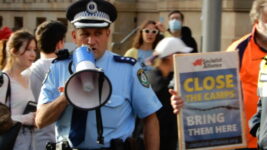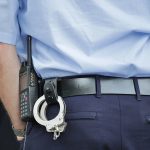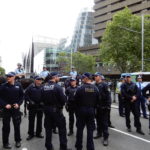What is a Police ‘Move On Direction’ in New South Wales?

Health Minister Brad Hazzard has slammed ‘backpackers’ who partied in Bronte Park on Christmas Day, saying they blatantly ignored physical distancing advice.
Up to 500 people gathered for the event, with beers in hand, allegedly ignoring the alcohol free rules and physical distancing advice.
Mr Hazzard told the press that if these young people were back home right now, many of them would be in lockdown and not even allowed outside their homes. He expressed concerns that the event could become an incubator for spreading COVID-19.
The riot squad was brought in to break up the event, and one man was issued with a court attendance notice for allegedly failing to move on when directed by police to do so.
Earlier incident
In May 2020, video footage showing crowds of Sydney-siders at Bondi Beach, sparked the closure of beaches across New South Wales along with the introduction of a number of harsh new rules.
Health Minister Brad Hazzard has been quick to remind the residents of this area – many of whom are young international travellers – that they are required to abide by public health orders relating to COVID.
Move on directions
Part 14 of the Law Enforcement (Powers and Responsibilities) Act 2002 (NSW) (‘the LEPRA’) sets out the rules for move on directions in New South Wales.
The general power to move on
Section 197(1) of the LEPRA provides that:
A police officer may give a direction to a person in a public place if the officer believes on reasonable grounds that the person’s behaviour or presence in the place:
- Is obstructing another person or persons or traffic,
- Constitutes harassment or intimidation of another person or persons,
- Is causing or likely to cause fear to another person or persons, so long as the relevant conduct would cause fear to a person of reasonable firmness,
- Is to unlawfully supplying a prohibited drug, or
- Is to unlawfully obtain, procure or purchase any prohibited drug.
What is a ‘public place’?
A ‘public place’ is defined as:
- A place (whether or not covered by water), or part of premises, that is open to the public or is used by the public, whether or not on payment of money or other consideration, whether or not the place or part is ordinarily so open or used and whether or not the public to whom it is open consists only of a limited class of persons, or
- A road or road related area.
A ‘road related area’ is:
- an area that divides a road, or
- a footpath or nature strip adjacent to a road,
- an area that is open to the public and is designated for use by cyclists or animals, or
- an area that is not a road and that is open to or used by the public for driving, riding or parking vehicles, or
- a shoulder of a road, or
- any other area that is open to or used by the public and that has been declared under section 18 to be an area to which specified provisions of this Act or the statutory rules apply
Direction must be reasonable and warranted
Subsection 197(2) of the LEPRA imposes the following limitations on the exercise of move on powers:
A direction given by a police officer under this section must be reasonable in the circumstances for the purpose of:
- Reducing or eliminating the obstruction, harassment, intimidation or fear,
- Stopping the supply, or soliciting to supply, of the prohibited drug, or
- Stopping the obtaining, procuring or purchasing of the prohibited drug.
Move on directions to intoxicated persons
Section 198(1) of the LEPRA gives police the power to direct a person to leave a public place and not return for a specified person of time if the officers believes on reasonable grounds that the person’s behaviour is likely to cause injury to any other person or persons, damage to property or otherwise give rise to a risk to public safety, or is disorderly.
A person is considered to be ‘intoxicated’ if:
- His or her speech, balance, co-ordination or behaviour is noticeably affected, and
- It is reasonable in the circumstances to believe the affected speech, balance, co-ordination or behaviour is the result of the consumption of alcohol or any drug.
Section 198(2) imposes the requirement that the direction must be reasonable in the circumstances and for the purpose of preventing:
- Injury or damage or reducing or eliminating a risk to public safety, or
- The continuance of disorderly behaviour in a public place.
Section 198(6) requires an officer to warn the recipient of a direction that it is an offence to be intoxicated and disorderly in that or any other public place at any time within 6 hours after the direction is given.
The warning is additional to that which is outlined below.
Move on directions to groups
Section 198A of the LEPRA empowers police officers to give the directions outlined in the preceding sections, to groups of persons.
In that event, the officer is not required to repeat any required direction, information or warning to each member of the group, however the fact an officer doesn’t repeat the direction does not give rise to a presumption that every member of the group received the direction, information or warning.
So, in the event the group is a large or dispersed one, the officer will need to ensure all members of the group have heard the direction, information or warning.
What happens if I fail to comply with a move on direction?
Section 199 of the LEPRA prescribes a fine of two penalty units (or $220) for any person who fails to comply with a move on direction without a reasonable excuse.
The section makes clear that a person is not guilty unless it is established that he or she persisted, after the direction was given, to engage in the conduct which gave rise to the direction.
In addition to this, section 204B of the LEPRA stipulates that a person is not guilty of failing to move on unless the officer giving the direction has complied with all of the requirements related to the direction, including providing information and a warning as outlined below.
Limitations on giving move on directions
Section 200 of the LEPRA prohibits police from giving move on directions in relation to:
- Industrial disputes,
- Genuine demonstrations or protests,
- Processions, or
- Organised assemblies.
However, an officer can give a move on direction in relation to a demonstration, protest or procession if he or she believes on reasonable grounds that:
- The direction is necessary to deal with a serious risk to the safety, or
- Traffic is being obstructed and the event is not an authorised public assembly or in not being held substantially in accordance with its authorisation, and the police officer in charge of the scene has given the direction, and the direction is limited to those who are obstructing traffic.
Requirement to provide information
Section 202 of the LEPRA requires officers who are exercising the power to issue a move on direction to provide:
- Evidence that he or she is a police officer, unless he or she is in uniform,
- His or her name,
- His or her place of duty, and
- The reason for the exercise of the power.
This information must be provided:
- As soon as it is reasonably practicable to do so, or
- Before giving or making any direction, requirement or request to a person.
Requirement to give warning
Section 203 of the LEPRA requires an officer to warn a person to whom a move on direction is given that failing to comply with the direction is an offence.
The warning must be given as soon as practicable after giving the direction.
An officer cannot issue an infringement or court attendance notice for failing to comply with a move on direction unless a warning has been issued.
NSW Police Force Code of Practice
According to the NSW Police Code of Practice, there is a two-step process for a warning:
- Police must tell you that you are required by law to comply with the request or direction as soon as possible after telling you to move on (unless you have already complied).
- If you refuse to move on after the first step, police are required to tell you that your failure to comply with the request is an offence.
Going to court?
If you have been accused of an offence and are going to court, call Sydney Criminal Lawyers anytime on (02) 9261 8881 for expert advice and outstanding legal representation.
We offer a free first appointment for anyone who is going to court for a criminal or traffic law offence, as well as fixed fees for most cases.






